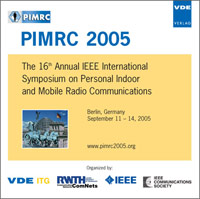Service Provisioning with Ad-Hoc Deployed High-Speed Access Points in Urban Environments
Conference: PIMRC 2005 - 16th Annual IEEE International Symposium on Personal Indoor and Mobile Radio Communications
09/11/2005 - 09/14/2005 at Berlin, Germany
Proceedings: PIMRC 2005
Pages: 5Language: englishTyp: PDF
Personal VDE Members are entitled to a 10% discount on this title
Authors:
Hultell, Johan; Lungaro, Pietro; Zander, Jens (Radio Communication Systems, The Royal Institute of Technology, Electrum 418, 164 40 Kista, Sweden)
Abstract:
Exploiting user-deployed networks as part of a public infrastructure has been proposed as a concept to radically lower the cost of provisioning access and services in urban environments. An important question is how dense a network with spotty coverage has to be in order to support interesting services. In this paper, we introduce a framework for evaluating the user-perceived performance for two service types, a timecritical news subscription service (involving streaming) and a more delay tolerant entertainment service ("web browsing"). The user terminals contain a memory cache and an "agent" that opportunistically downloads and stores relevant pieces of information as users walk close to the access points. Results show that above a critical access point density, that is still significantly lower than the one required for continuous coverage, the services start performing very well with little or no outdated information. In most studied scenarios, we are communication limited meaning that memory capacity is not a problem, but energy is.


